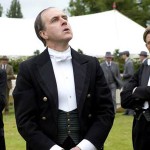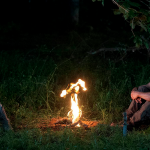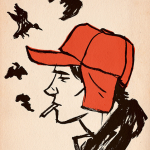This past weekend, I attended the Midwestern Regional Meeting of the Conference on Christianity and Literature, held at Wheaton College (which also happens to be my alma mater). The theme of the conference was “The City,” and over the course of three days, panelists and attendees discussed both the representation and the influence of the city in literature, from ancient works to post-9/11 fiction. I’ll share here a few of the insights gained from my fellow panelists and speakers. Some of the discussions are definitely geared towards literature scholars, but I also hope there will be moments of interest for anyone who cares about the points of conjunction and conflict between the Earthly City and the City of God.
Thursday, September 26, 2009
Panel: “The Dramatic City”
The first presenter I heard during the conference, Jonathan Gates of Nyack College, began his presentation, “Running to the City of Refuge: Blanche’s Flight to New Orleans,” with a lament that, when he teaches A Streetcar Named Desire, his students often side with the brutal Stanley Kowalski, rather than the fragile Blanche. He mentioned his concern that there is “so little grace extended to Blanche.” I’ve observed this phenomenon myself, especially if I show the movie version of the play, and it’s one reason that I ask myself every semester if I really want to teach Streetcar. Gates made comparison between the Old Testament cities of refuge and the way New Orleans functions in Williams’s play. Blanche feels guilt over having “killed” (driven to suicide, in her view) the husband of her youth, and Stanley ends up acting as the avenger of blood. For a time, New Orleans provides a refuge for Blanche, but Stanley becomes Blanche’s final judge—and destroys her. In this presentation, the city of refuge parallel was interesting, but I’m still trying to figure out how it would help students extend more grace to Blanche. What do we do, as teachers and readers, when other readers don’t have compassion for the “right” character?
The second presenter, Kari Anne Innes of Bowling Green State University, also made a connection between the Old Testament and a 20th-century American play in her presentation, “Devout Atheist: Influence of Black Church Theatre and the Book of Ruth in Lorraine Hansberry’s A Raisin in the Sun.” According to Innes, critics have been too hasty to assume that Hansberry’s own militant atheism is the only lens through which one can examine the role of religion in Raisin. Innes pointed out that Raisin was at least in part inspired by productions put on by black churches, since those were some of the few venues in which African American theater could be seen in New York. Because of this reality, Hansberry also began writing her play with the assumption that it would be performed in a church (though this didn’t turn out to be the case). Innes also pointed out that the structure and characters in Raisin resemble the characters in the biblical book of Ruth. Like Naomi, Lena Younger, the family matriarch, relocates twice for her family’s welfare: first from the South to the North, and then from Southside Chicago to mostly white Clyburn Park. Lena’s daughter-in-law, Ruth (who parallels . . . Ruth), stays intensely loyal to her, while her own flesh-and-blood daughter bears more similarity to the biblical Orpah. Like Orpah, Beneatha (who is usually seen as a stand-in for Hansberry herself), rejects her mother’s God and wants to return to “her” people (Beneatha is taken up with the early “back to Africa” movement). Of course, unlike the book of Ruth, Lena’s biological son, Walter Lee, is still alive—and, in fact, as Innes pointed out, he came to dominate the play far more than Hansberry intended, due to the urging of producers and of actor Sidney Poitier himself. Walter Lee Younger became the focus of the play, a fact that masks some of the Ruthian parallels.
Keynote Address: “America: A Tale of Two Cities?”
Andrew Delbanco, author of Melville: His World and Work and The Death of Satan: How Americans Have Lost the Sense of Evil
Delbanco began his keynote with an ode to New York City, which has been his lifelong home, and a few good-natured digs at Chicago. He then launched into a survey covering almost 400 years of depictions of the city in American literature. Of course, John Withrop’s “city on a hill” reference in his sermon “A Model of Christian Charity” received the first notable mention.
Then, in the 18th century, Benjamin Franklin and Thomas Jefferson embodied opposing attitudes to the city. Jefferson, as an agrarian, opined that city life is subject to the “caprice of customers.” (At this point, Delbanco inserted an anachronistic comment from writer Mike Rose about how waiting on tables is the quintessential urban job. The modern restaurant, as a symbol of the city, is a place where city-dwellers enact “public intimacy” on a daily basis.) Franklin actually had much the same view of the city as consumer-driven, but he loved what Jefferson loathed. He reveled in the city life because it trafficked in appearances rather than reality. These, then, are the two cities of American life.
Delbanco, as a Melville biographer, perhaps not unsurprisingly chose the author of Moby Dick as a writer who in some way reconciled these two cities. Melville’s portrayal of New York, especially Wall Street, in “Bartleby, the Scrivener” is famously negative: the city comes across as a place devoid of charity. However, Delbanco argues that Melville was also inspired and excited by the city, so much so that he felt driven to create a new literary style to embody it. This style, according to Delbanco, epitomizes brashness above all.
Delbanco mostly left the 20th century out of his survey, but he did mention a brief, telling anecdote about F. Scott Fitzgerald (whose birthday it was, incidentally). Upon going to the top of the Empire State Building, Fitzgerald became depressed, because he saw that the city did indeed have limits.
While I appreciated Delbanco’s chronological approach, since one of the courses I teach every semester is Survey of American Literature, I did wish that he had dealt more with the “two cities” stated as his topic. The title also alludes, I think, to Mario Cuomo’s famous speech, given in response to Reagan’s frequent invocation of Winthrop’s “city upon a hill,” but this connection wasn’t fully developed. I left the presentation wondering to what extent it is the responsibility of urban literature to deal with both cities: city as utopia and city as dystopia.











